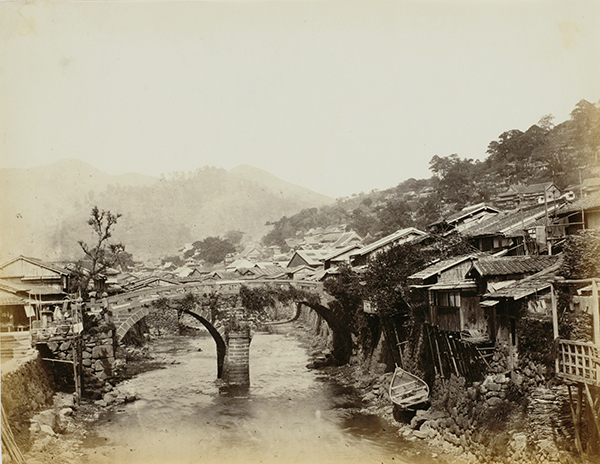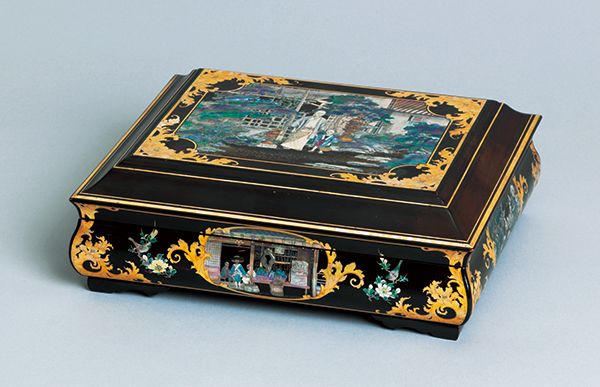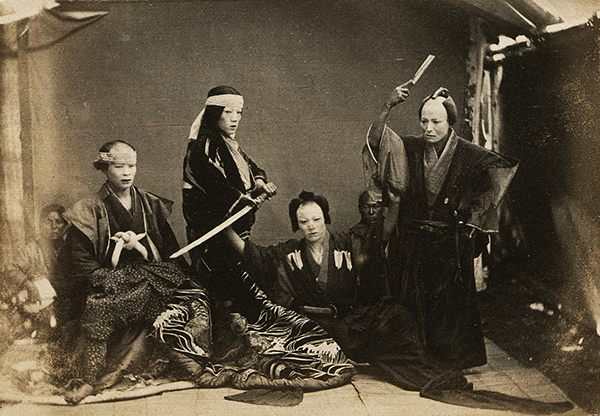 |
Focus features two in-depth reviews each month of fine art, architecture and design exhibitions and events at art museums, galleries and alternative spaces around Japan. The contributors are non-Japanese residents of Japan. |
|
|
 |
 |
 |
Nagasaki through Early Photographs: Revisiting the City of Dreams
Alice Gordenker |
 |
View of Nagasaki Harbor as photographed in 1861 by the Prussian East Asian Expedition. Albumen print, one portion of a seven-panel panorama. Collection of Tokyo Photographic Art Museum |
Nagasaki holds a special place in the history of photography in Japan. Not only was it the portal through which this foreign technology entered the country, it was also one of the first places in Japan to be captured in photographs. Some of the most accomplished photographers of the 19th century passed through Nagasaki at some point in their careers, leaving behind valuable records of the city and how it grew. And this beautiful port town produced some of Japan's earliest and most celebrated photographers.
This fascinating history is presented in a colorful exhibition that runs through 6 May at the Tokyo Photographic Art Museum. Titled Geneses of Photography in Japan: Nagasaki, it is the first of three shows that will explore the starting points of photography in Japan. (The others, to be organized over the next few years, will look at Hokkaido and Tokyo; dates for those shows have not yet been announced.)
The exhibition presents superlative examples of early photographs of Japan, along with maps, paintings, woodblock prints and photographic equipment. Photo by K Photo Service |
While there will be plenty in this first show to satisfy hard-core photography geeks -- including a portable folding darkroom made for the battlefield, and rare images from Nagasaki University's superb collection of early photos -- this is an entry-level exhibition that presumes no prior knowledge of either photography or Nagasaki. It is, more than anything, a chance to journey back through time to a city of dreams that no longer exists.
Color woodblock print of a live elephant that was brought to Japan in 1813, arriving in Nagasaki aboard a Dutch ship. Collection of Nagasaki Museum of History and Culture |
In 1839, the year the daguerreotype was announced in France as the first practical method of photography, Nagasaki was the most exciting and cosmopolitan city in all of Japan. Despite an official policy of national seclusion, many non-Japanese lived and worked in this rapidly growing port. Many people may still hold the impression that the only international presence at the time was the tiny Dutch trading post of Dejima, situated within Nagasaki's harbor and sanctioned by the Tokugawa shogunate, but there were, in fact, Europeans from other countries, including England, France and Russia, along with a much larger population of Chinese and other Asians. With so many new people, objects and ideas entering the port, Nagasaki was the vanguard of learning in Japan. Promising scholars were sent from all over the country to study Western medicine and science, and the fields of investigation were so different from what was available elsewhere that a stint in Nagasaki was essentially "study abroad."
The first section of the exhibition uses books, maps and woodblock prints to introduce Nagasaki as it was until the mid-19th century, before the arrival of photography. Because of Japan's distance from Europe, and restrictions on the flow of goods and information, the technology reached Japan nearly a decade after it had spread throughout Europe and North America; the first camera imported to Japan arrived only in 1848, to Nagasaki and aboard a Dutch ship. This first part of the show is a fine opportunity to see a type of woodblock print known as Nagasaki hanga. Produced on low-grade paper from quickly carved woodblocks, these relatively simple prints were sold as inexpensive mementos to merchants and scholars who visited the city. Foreign people and foreign ships were popular subjects, as were the many exotic animals and birds that were brought, alive, to Nagasaki from other lands, including elephants, camels, and cassowaries.
 |
|
The Meganebashi bridge, now a famous symbol of Nagasaki, as photographed by Felice Beato around 1866. Albumen print. Collection of Tokyo Photographic Art Museum |
Then came photography, and with it, foreign photographers. Some, like the Swiss photographer Pierre Joseph Rossier who arrived in 1859, came for commercial reasons, eager to make the first photographic images of a country that was largely unknown in Western markets. Others came on government missions from Europe, charged with making photographic records to enhance official reports. August Sachtler, for example, landed in 1861 as part of an expedition from Prussia. Although hired as a telegrapher, he was forced, when the official photographer proved incompetent, to learn photography on the job, and his pictures rank among the earliest taken in Japan. Felice Beato, one of the world's most famous photographers at the time, arrived about two years later, capturing some of the most beautiful early images of Japan. All three spent time in Nagasaki.
Although Japanese researchers had already been experimenting with the technology -- the oldest known photograph taken by a Japanese was made in 1857 -- their progress in sorting out what was then a very complicated process advanced quickly through contact with foreign practitioners. One of the most skilled and successful Japanese photographers was Hikoma Ueno, who opened a studio in Nagasaki in 1862. The exhibition includes works by all these men as well as by lesser-known photographers who followed, and many of the images have never been exhibited in Tokyo before. But unlike previous shows that charted the development of photography or marked the accomplishments of individuals, here the primary purpose is to construct a visual account of Nagasaki in the 19th century before and after Japan set off on a course of rapid modernization. Thus, the emphasis is not on portraits but on landscape photography, including city views and broad panoramas.
 |
|
 |
|
Left: Lacquerware box, inlaid with mother-of-pearl, ivory and gold; collection of Nagasaki Museum of History and Culture. Right: An 1861 photograph by August Sachtler that was clearly referred to by the artist in creating one of the scenes on the box; collection of Nagasaki University Central Library |
One particularly fascinating exhibit is a large lacquerware box inlaid with scenes of Nagasaki that we now know were copied from photographs, showing how quickly and inventively people put the imported technology to practical use. The box is presented in the same glass case with three photographs that are so similar to scenes on the box that there is no doubt that the artist was working from them. Although the remaining scenes have yet to be matched up to photographs, it is entirely possible that these sources, too, may yet be identified as previously unknown photographs turn up in uncatalogued archives and private collections.
This year is the 150th anniversary of the Meiji Restoration of 1868, which launched a period of dramatic change as the Japanese government embarked on the creation of a Western-style nation. In commemoration, there will be special exhibitions and events all over the country. In that context, Geneses of Photography in Japan: Nagasaki provides an excellent introduction, especially for visitors from overseas who struggle with exhibits that rely heavily on texts in Japanese, because it presents a visual record of one of Japan's most important and dynamic cities as the country transitioned from feudalism to a modern society.
All images provided by the Tokyo Photographic Art Museum.
|
 |
 |
Alice Gordenker
Alice Gordenker is a writer and translator based in Tokyo, where she has lived for more than 18 years. For over a decade, she penned the "So, What the Heck Is That?" column for The Japan Times, providing in-depth reports on everything from industrial safety to traditional talismans. She translates and consults for museums, and has a special interest in making Japanese museums more accessible for visitors from other countries. |
|
 |
|